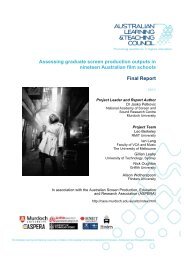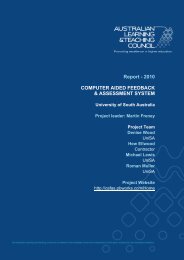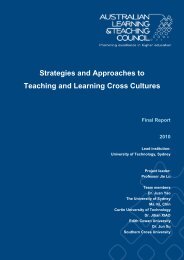student feedback and leadership - Office for Learning and Teaching
student feedback and leadership - Office for Learning and Teaching
student feedback and leadership - Office for Learning and Teaching
Create successful ePaper yourself
Turn your PDF publications into a flip-book with our unique Google optimized e-Paper software.
Student Feedback & LeadershipART presentations included:The School of Mathematical <strong>and</strong> Geospatial Sciences ART leaderreiterated the importance of ensuring that <strong>student</strong>s recognise their role in theirown learning. Students need to be in<strong>for</strong>med of the purpose <strong>and</strong> importanceof the CES <strong>and</strong> how to differentiate between teaching practices <strong>and</strong> learningspace <strong>and</strong> IT/AV issues.<strong>Teaching</strong> practices identified as most important in <strong>student</strong> <strong>feedback</strong> includedthe need to provide context-related exemplars appropriate to the variousdisciplines <strong>and</strong> the need <strong>for</strong> timely <strong>feedback</strong> to <strong>student</strong>s. Above all, the value<strong>and</strong> importance of staff working as a team to share ideas was emphasised.The School of Property, Construction <strong>and</strong> Project Management ARTleader reiterated the need to ensure that learning spaces are appropriate<strong>for</strong> the learning style of the academic teacher. In addition there is the needto ensure that technology is updated to ensure <strong>student</strong>s have accessto the latest resources <strong>for</strong> learning.The ART leader also emphasised the need <strong>for</strong> teaching <strong>and</strong> assessmentpractices to be continually improved <strong>and</strong> provided an example of theintroduction of a more reflective learning <strong>and</strong> assessment approachthat had a significant impact on <strong>student</strong> learning.The School of Economics, Finance <strong>and</strong> Marketing ART emphasisedthe need to develop a transition program to assist <strong>student</strong>s to develop frompassive to active learners <strong>and</strong> to provide more opportunities <strong>for</strong> individual<strong>feedback</strong> <strong>and</strong> attention. This requires support from the <strong>for</strong>mal <strong>leadership</strong>in providing time <strong>and</strong> resources.The three LTIF supported <strong>student</strong> <strong>feedback</strong> project leaders identified issues of:––Providing opportunities <strong>for</strong> <strong>student</strong> self-assessment of their knowledge.––Designing <strong>for</strong>mative assessment spread over a semester withappropriate weighting.––The importance of using statistical analysis to identify meaningful <strong>feedback</strong>to academic teaching staff on <strong>student</strong> <strong>feedback</strong>.The presentation by Student Services identified the importance of respondingto general <strong>for</strong>mal <strong>student</strong> <strong>feedback</strong> about their University experience. In 2007a comprehensive analysis of <strong>student</strong> <strong>feedback</strong> data sources over the precedingfive years was undertaken 3 . From this analysis four persistent themesof <strong>student</strong> concern were identified:––teaching staff <strong>and</strong> quality;––program structure <strong>and</strong> course content;3 Discussions with commencing <strong>student</strong>s 2007 Volume 1 Summary of findingsDrawing on the StudentExperience Survey (SES), Course Experience Questionnaire (CEQ) <strong>and</strong> Student Outcomes Survey (SOS).Page 60
















